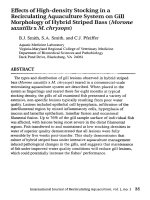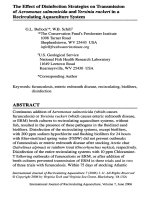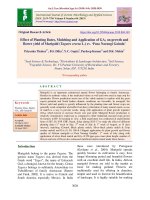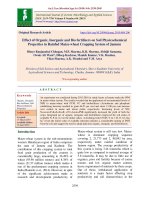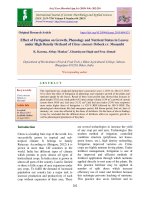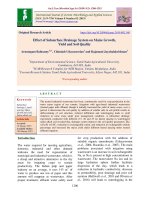Effect of high density planting system (HDPS) and varieties on yield, economics and quality of Desi cotton
Bạn đang xem bản rút gọn của tài liệu. Xem và tải ngay bản đầy đủ của tài liệu tại đây (312.98 KB, 6 trang )
Int.J.Curr.Microbiol.App.Sci (2017) 6(3): 233-238
International Journal of Current Microbiology and Applied Sciences
ISSN: 2319-7706 Volume 6 Number 3 (2017) pp. 233-238
Journal homepage:
Original Research Article
/>
Effect of High Density Planting System (HDPS) and Varieties
on Yield, Economics and Quality of Desi Cotton
Pradeep Kumar1,2*, A.S. Karle1, Deshraj Singh1 and Lalita Verma1
1
Department of Agronomy, College of Agriculture, VNMKV, Parbhani,
Maharashtra – 431402, India
2
Department of Agronomy, CCS Haryana Agricultural University, Hisar,
Haryana – 125004, India
*Corresponding author
ABSTRACT
Keywords
Desi cotton, HDPS,
Economics, Quality,
Varieties, Yield.
Article Info
Accepted:
08 February 2017
Available Online:
10 March 2017
Investigation of new cotton production strategies is needed to enhance the productivity and
profitability. A field experiment was conducted in clay textured soil during Kharif season
of 2014-15 to evaluate the effect of High Density Planting System (HDPS) and varieties
on yield, economics and quality of desi cotton at Cotton Research Scheme, VNMKV,
Parbhani. The experiment was laid out in split plot design consisting of four levels of plant
densities viz., 45 x 15 (148148 plants/ha), 45 x 22.5 (98765 plants/ha), 45 x 30 (74074
plants/ha) and 60 x 10 cm2 (166666 plants /ha) in main plots and three levels of desi cotton
varieties i.e., PA 08, PA 528 and PA 255 in sub plots. The result of experiment indicated
that significantly higher seed cotton yield (2063 kg/ha), gross return (87586 ₹ /ha ), net
monetary returns(50031₹ /ha) and B: C ratio (2.33) was recorded at plant spacing of 45 x
15 cm2 as compared to other spacing. The quality parameters were not influenced
significantly with plant densities however; highest seed index (5.36 g) was obtained with
45 x 30 cm2. The desi cotton variety PA 528 produced highest seed cotton yield (2085
kg/ha), gross return (88017₹ /ha), net monetary returns (50623₹ /ha) and B: C ratio (2.34),
ginning % (39.14), seed index (5.29) and lint index (3.40) than PA 08 and PA 255
varieties. Halo length was not affected considerably with desi cotton varieties.
Introduction
crops next to food grains that play a vital role
in Indian national economy (Patel et al.,
2016). In India cotton is grown over an area
of 115.53 lakh hectares with production of
375.00 lakh bales with productivity of 552 kg
lint/ha
(Anonymous,
2014).
Cotton
production in India is considered to have a
wide reaching impact not only on the
livelihood of farmers and economy of the
country but also on international trade. Even
though maximum area is under Bt cotton but
Vigilant production and economic strategies
are important for cotton growing farmers due
to expanding cost of cultivation and
stagnating productivity. Adoption of High
density Planting System (HDPS) and newly
released desi cotton varieties offer an
alternate to sustainable production and
decrease production cost. Cotton (Gossypium
spp.), the queen of fibre or white gold, is one
of the most important commercial crop of
India. It is one of the most important cash
233
Int.J.Curr.Microbiol.App.Sci (2017) 6(3): 233-238
average productivity is lower than world
average. Cotton productivity depends on
various factors among them selection of
potential genotypes along with plant densities
play a vital role in increasing the productivity
of cotton. The desi cotton are known to
tolerant and resistant to diseases, pests and
adverse environmental condition while,
American cotton varieties are more
susceptible to insect pests like jassids,
whiteflies, aphids and diseases bacterial
blight, verticillium wilt and leaf curl virus and
because of high cost of cultivation they are
also considered as major cause of farmer’s
suicide. New desi cotton genotype viz., PA
08, PA 528have been released in recent times
by VNMKV, Parbhani. The maximum
exploitation of these genotypes can be
achieved only after determining their
optimum planting densities in comparison to
recommended cotton varieties. In general, it
was observed that lower plant densities
produces high values of growth and yield
attributes per plant, but yield per unit area was
higher with higher plant densities (Namdeo et
al., 1991; Dhoble et al., 1992; Sharma et al.,
2001). However, it may happen that moderate
increase in plant densities may not increase
the yield but decrease due to competition
between plants for nutrients, water, space and
light (Nehra and Kumawat, 2003). In view of
the above, present research work carried out
with the objective to find out the effect of
High Density Planting System (HDPS) on
yield, economics and quality of desi cotton.
electrical conductivity were 7.86, 0.70% and
0.48 ds/m, respectively. Geographically
Parbhani is situated at 19o16’ North latitude
and 76o47’ East longitude and at 409 altitude
above sea level in Marathwada division
encompassed by 17o35’ to 24o40’ North
latitude and 74o49’ to 78o15’ East longitude
geographical boundaries. Parbhani comes
under subtropical climate. The mean daily
maximum and minimum temperatures varies
from 29.16 in December to 41.14 in May and
11.95 in December to 24.95 in May,
respectively. It has a mean annual
precipitation of 963 mm, distributed in 48
rainy days, mostly during June to October.
Mean relative humidity ranges from 30 to 90
percent. The experiment was laid out in split
plot design with four levels of plant densities
i.e. 45 x 15, 45 x 22.5, 45 x 30 and 60 x 10
cm2 in main plots and three levels of desi
cotton varieties i.e., PA 08, PA 528 and PA
255 in sub plots. The crop was sown on 11th
July 2014 (27th MW) by dibbling 2 cotton
seeds per hill as per the spacing. The
fertilizers were applied as per treatments. Half
dose of nitrogen and complete dose of P2O5
and K2O was applied through urea and
10:26:26 fertilizer as basal application. Top
dressing of remaining half dose of nitrogen
was given after 30 days after sowing through
urea by ring method. The plant height was
measured in cm from the base of the plant i.e.,
ground level to the base of the last fully
opened leaf at the apex of plants. The weight
of dry matter accumulated in plant is an index
of the plant growth. The roots of the plant
uprooted for dry matter study, were removed
and after removing the roots, the plant were air
dried under sun for eight days and
subsequently dried in the thermostatic oven at
65 20C, till they were completely dried. The
final constant dry weight was recorded as
total dry matter weight in gram per plant.
Ginning per cent was calculated treatment
wise for second picking (as the yield of seed
cotton was more in the second picking) using
the following formula:
Materials and Methods
The experiment was conducted at Cotton
Research Scheme, VNMKV, Parbhani during
2014-15. The topography of experimental
field was fairly uniform, leveled and with a
good drainage. The soil was clayey in texture
with low in available nitrogen (157.51 kg/ha),
medium in available phosphorus (9.68 kg//ha)
and high in available potassium (466.86
kg/ha). The soil pH, organic carbon and
234
Int.J.Curr.Microbiol.App.Sci (2017) 6(3): 233-238
Lint weight (g)
Ginning per cent = ------------------------ x 100
Seed cotton weight (g)
The increase in dry matter accumulation per
plant at wider spacing mainly due to the
larger ground area, maximum moisture, more
nutrients and more light interception resulting
in more photosynthetic activity and more
biomass accumulation through the process of
plant metabolism Moola and Giri (2006);
Butter and Singh (2007). With respect of
varieties maximum dry matter accumulation
was observed from PA 528 (76.49 g) than PA
08 and PA 255.
The ginning percent alone does not convey
any idea about the total production of fibres
hence; lint index was calculated to overcome
this drawback by using the following formula.
Weight of 100 seeds x Ginning (%)
Lint index = ----------------------------------100 – Ginning (%)
Yield contributing characters, yield and
economics
Seed index ensures evaluation of types with
properly developed seeds and leads to
development of lint index. It was worked out
by taking weight of 100 seeds (g) from each
net plot after ginning. Other biometric
observations were recorded as per the
standard procedure.
The significantly higher number of picked
bolls per plant (15.56) and seed cotton yield
per plant (25.67 g) were under wider plant
spacing of 45 x 30 cm2 due to better
development of individual plant in wider
plant spacing crop. The widely spaced plant
received optimum microclimate and the
beneficial influence on plant development.
Similar results were observed by Nehra and
Chandra (2001). The mean boll weight was
not significantly influenced by different plant
densities as reported by Moola and Giri
(2006).The sowing of cotton at 45 x 15 cm2
plant spacing produced considerably highest
seed cotton yield (2063 kg/ha), the maximum
gross monetary return (87586 Rs/ha) and net
monetary returns (50031 Rs/ha) and B: C
ratio (2.33) as compared to wider spacing due
to more number of picked bolls per unit area.
At 60 x 10 cm2 spacing seed cotton yield
(1798 kg/ha) was decreased because the
reduction in yield per plant due to both interplant and intra- plant competition for
resources, was more than compensated by
increase in the number of plants per unit area.
These above are in accordance with those
obtained by Giri and Gore (2006); Buttar and
Singh (2007); Narayana and Aparna (2011).
Results and Discussion
Results on yield, economics and quality of
desi cotton as influenced by various
treatments are presented in table 1.
Growth characteristics
At harvesting stage, the plant height was
maximum (138.43 cm) when sowing was
done at spacing of 60 x 10 cm2 (Fig. 1). The
more number of plants per unit area resulted
more height per plant which may be due to
the increased competition for sunlight and
CO2. Similar type of results was reported by
Wankhade et al., (2003); Narayana et al.,
(2007); Sisodia and Khamparia (2007). The
minimum height of crop was recorded with 45
x 30 cm of plant spacing. Among varieties,
PA 528 results significantly highest plant
height (140.74 cm) as compared to other. At
harvesting
stage,
total
dry
matter
accumulation per plant was influenced due to
different spacing and it was maximum (78.64
g) in wider plant spacing 45 x 30 cm2 as
compared to 45 x 22.5, 45 x 15 and 60 x 10
cm2 plant spacing.
235
Int.J.Curr.Microbiol.App.Sci (2017) 6(3): 233-238
Table.1 Effect of High Density Planting System (HDPS) and varieties on seed cotton yield, economics and quality of desi cotton
Treatments
Picked
bolls
/plant
Boll
weight
(g)
Yield
(g)
/plant
Seed
cotton
yield
(kg/ha)
Economics
Cost of
Gross
Net
cultivation monetary monetary
(₹ /ha)
returns
returns
(₹ /ha)
(₹ /ha)
B:C
ratio
Quality
Ginning Seed
Lint
%
Index Index
(g)
(g)
Halo
length
(mm)
Plant densities (plants/ha)
148148
(45x15
cm2)
98765
(45x22.5
cm2)
74074 (45x30 cm2)
14.04
1.67
19.56
2063
37555
50031
2.33
37.30
5.21
3.11
22.74
40255
2.12
37.07
5.32
3.14
22.88
33338
1.94
36.93
5.36
3.15
23.01
41093
2.12
37.77
5.03
3.06
21.79
137
8758
6
7603
2
6790
3
7752
4
1085
14.67
1.84
24.33
1807
35776
15.56
1.90
25.67
1621
34565
166666
cm2)
SEm+
10.16
1.67
14.89
1798
36431
0.25
0.02
0.38
27.46
987
0.02
0.20
0.01
0.02
0.14
CD (P=0.05)
0.86
NS
1.32
95.05
475
3754
3418
0.08
NS
0.06
NS
NS
Varieties
PA 08
14.25
1.70
20.91
1803
35987
40510
2.11
34.70
5.12
2.71
22.49
1.89
24.66
2085
37393
50623
2.34
39.14
5.29
3.40
22.67
11.91
1.70
17.75
1579
34865
32404
1.91
37.94
5.28
3.23
22.64
SEm+
0.09
0.01
0.29
18.11
90
7649
8
8801
7
6726
9
705
PA 528
14.65
PA 255
615
0.01
0.05
0.01
0.01
0.17
CD (P=0.05)
0.29
NS
0.87
54.30
271
2115
1844
0.04
0.16
0.03
0.03
NS
(60x10
236
Int.J.Curr.Microbiol.App.Sci (2017) 6(3): 233-238
Fig.1 Plant height and dry matter accumulation of desi cotton as influenced
by different plant densities and varieties
The desi cotton variety PA 528 produced
significantly more number of picked boll per
plants (14.65), yield per plant (24.66 g), yield
per hectare (2085 kg), gross return
(88017₹ /ha),
net
monetary
returns
(50623₹ /ha) and B: C ratio (2.34) than PA 08
and PA 255. This might be due to high
genetic vigour. However, boll weight and
hallo length was not affected significantly due
to different desi cotton varieties.
(3.40) than PA 08 and PA 255.This might be
due to high genetic vigour. However, boll
weight and hallo length was not affected
significantly due to different desi cotton
varieties.
In conclusion, growing desi cotton at plant
density of 148148 (45x15 cm2) provided
highest seed cotton yield, gross and net
monetary return, B: C ratio without
significant effect on quality on the other hand,
among desi cotton varieties PA 528 provided
highest seed cotton yield, gross and net
monetary return and B: C ratio with high
quality parameters excluding halo length.
Quality parameters
The quality characters viz., ginning
percentage, lint index, harvest index and halo
length were not significantly influenced by
various spacing under study. These quality
parameters are controlled by genes and
nutrition. Since recommended dose of
fertilizer was same for all varieties hence
variation in quality parameters were not
observed significantly. The results are in
conformity with those noted earlier by Chabra
et al., (1995) and Dhillon et al., (2006).
However, seed index was founded
significantly higher (5.36 g) at wider spacing
of 45x30 cm2. Similar trend was observed by
Dhillon et al., (2006). The desi cotton variety
PA 528 produced significantly higher ginning
% (39.14), seed index (5.29) and lint index
Acknowledgement
The author is thankful to Dr. A.S.Jadhav,
D.D.R. and In charge of Cotton Research
Scheme, Parbhani for providing land, inputs
and other facilities required for conducting
the above experiment.
References
Anonymous. 2015. Annual progress report of
cotton.www.cab.com.
Buttar, G.S. and Singh, S. 2007. Effect of date
of sowing and plant spacing on the
237
Int.J.Curr.Microbiol.App.Sci (2017) 6(3): 233-238
growth and yield of desi cotton
(Gossypiumarboeum L.). J. Cotton Res.
Dev., 21(1): 49-50.
Chabra, K.L., Bishnoi, K.C. and Madan, V.K.
1995. Quality of American cotton
varieties as affected by plant spacings and
nitrogen levels. J. Cotton Res. Dev., 9(2):
121-126.
Dhillon, R.N., Chabra, K.L. and Punia,
S.S.2006. Effect of crop geometry and
integrated nutrient management on fibre
quality and nutrient uptake by cotton
crop. J. Cotton Res. Dev., 20(2): 221-223.
Dhoble, M.V., Shaikh, M.Z., Patil, V.D., Giri,
D.G. and Pawar, B.R. 1992. Performance
of different cotton genotypes as
influenced by varying plant
row
spacings under rainfed conditions. J.
Cotton Res. Dev., 6(1): 128-134.
Giri, A.N. and Gore, S.B. 2006. Effect of plant
densities and NPK levels on yield of
newly released desi varieties of cotton. J.
Cotton. Res. Dev., 20(1): 77-79.
Moola, R. and Giri, A.N. 2006.Response of
newly released cotton (Goggypium
hirsutum) varieties to plant densities and
fertilizer levels. J. Cotton Res. Dev.,
20(1): 85-86.
Namdeo, K.N., Sharma, J.K., Choudhary, S.K.
and Mandloi, C. 1991. Effect of planting
dates and geometry on growth and yield
of hirsutum cotton under rainfed
condition. J. Cotton Res. and Dev., 5(1):
59-62.
Narayana, E. and Aparna, D. 2011. Performance
of cotton varieties (Gossypiumarboreum
L.) under different spacings and nitrogen
levels in black cotton soils of coastal
Andhra Pradesh. J. Cotton Res. Dev.,
25(1): 59-62.
Narayana, E.K. Hema, Srinivasula, K., Prasad,
N.V. and Rao, N.H.O. 2007. Agronomic
evaluation of G. hirsutum hybrid for
varied spacing and nitrogen levels in
vertisols under rainfed condition. J.
Cotton Res. Dev., 21(2): 197-200.
Nehra, P.L. and Kumawat, P.D. 2003. Response
of hirsutum cotton varieties to spacing
and nitrogen levels. J. Cotton Res. Dev.,
17(1): 41-42.
Nehra, P.L. and Chandra, M. 2001.
Performance of hirsutum cotton under
different sowing dates and spacing. J.
Cotton Res. Dev., 15(2): 147-150.
Patel, P., Patel J.C., Vyas, K.G. and Salvi D.
2016.Effect of hybrids and varying
planting time on growth and productivity
in cotton (Gossypiumhirsutum L.).The
Bioscan, 11(1): 289-291 (Supplement on
Agronomy).
Sharma, J.K., Upadhayay, Mishra, U.S.,
Khamparia, S.K., and Andloi, K.C.M.
2001.Effect of spacing and fertility levels
on growth and yield of hirsutum
genotypes. J. Cotton Res. Dev., 15(2):
151-153.
Sisodia, R.I. and Khamparia, S.K. 2007.
American cotton varieties as influenced
by plant densities and fertility levels
under rainfed conditions. J. Cotton Res.
Dev., 22(1): 35-40.
Wankhade, S.T., Turkhade, A.B., Katkar, R.N.,
Sakhare, B.A. and Solanke, V.M. 2003.
Effect of plant population on growth and
yield of cotton hybrids under drip
irrigation with mechanical cultivation. J.
Cotton Res. Dev., 17(2): 142-145.
How to cite this article:
Pradeep Kumar, A.S. Karle, Deshraj Singh and Lalita Verma. 2017. Effect of High Density
Planting System (HDPS) and Varieties on Yield, Economics and Quality of Desi Cotton.
Int.J.Curr.Microbiol.App.Sci. 6(3): 233-238. doi: />
238
